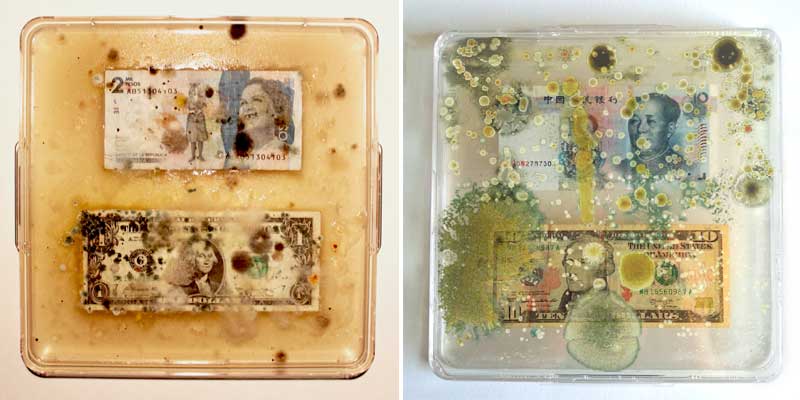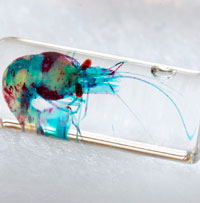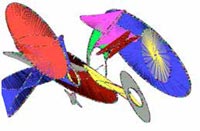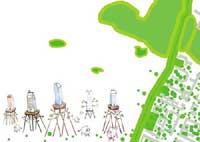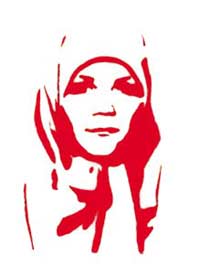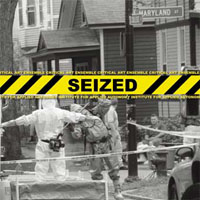
|
30
April 2021, 8pm - Virtual Vernissage at https://www.facebook.com/ArtLaboratoryBerlin
Last
exhibitions: and
With
the generous support of:
|
|||||||
|
|
previous exhibitions:
|
||||
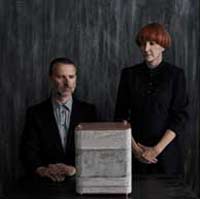 |
19.10-8.12.2019 Invisible Forces Erich Berger Mari Keto Martin Howse 19 October- 8 December 2019, Fri - Sun 2-6 PM Opening 18 October 2019, 8PM Artist Talk 19 October 2019, 5PM Local Area Network (LAN). Workshop with Martin Howse 13 Oct and 10 Nov 2019, 11AM-6PM (Registration required at m@1010.co.uk ) Our planet is not only made up of earth and rocks, but also of a number of invisible forces that influence and shape the form and viability of life. Radiation is not just a by-product of the atomic age, but something that exists in the background of almost every environment. In this exhibition, the work of Erich Berger and Mari Keto is presented along with a workshop and forensic exhibition by Martin Howse to open a dialogue between contemporary culture and deep (geological) time and psycho-geophysics. (More information) |
||||
 |
1.6.-14.7.2019 Opening:
31 May, 2019, 8PM
|
||||
 |
20.1.-17.3.2019 Watery Ecologies. Artistic Research Kat Austen | Mary Maggic | Fara Peluso Opening: 19 January 2019, 8PM 16 March 2019, 9 PM: HYDRO_PERFORMANCE Night. Performances, Talks with New Cassettes and Vinyls! With Kat Austen, Robertina Šebjanič and Fara Peluso Water is the foundation of life, making up 60% of our body. Water-born organisms produce much of the planet's oxygen. Meanwhile human activity fills waterways and oceans with plastics, industrial waste and diverse chemicals, effecting the metabolisms of most living creatures, ourselves included. This exhibition presents art projects on water, life and chemical disruption whose research transcends the boundaries between art and science. The artists pursue research in biology, chemistry and ethnography with distinct and radical DIY methods. Diverse approaches to the hydrosphere, the sum of the planet's water, explore the foundations of life and the threat of human impact on both the environment and our own bodies. (More information) |
||||
 |
22.09.-25.11.2018 Strange Encounters with Vegetal Others Špela Petrič Slovenian artist Špela Petrič approaches art production with a background in Hybrid Arts as well as a PhD in Biochemistry. These dual epistemological approaches inform her work with the Plant Kingdom as part of a multi-species collaboration exploring the ontologies, methodologies, ethics and practices of care involved in our relationship to the vegetal. Her first solo show in Berlin will give an insight into her multi-species endeavour. The green kingdom, upon which we depend for our very survival, functions on a radically different biological basis from us: seemingly inert, literally vegetative and endowed with unexplored forms of intelligence. Yet science reveals an intricate world of mysterious chemical conversations, interspecies networks and non-centralised operations alien from our own existence. Through her work Petrič proposes novel modes of human-plant communication, intercognition and exchange. (More information) |
||||
 |
24.03
- 13.05.2018 Viscous
Bodies |
||||
 |
30.9.
- 26.22.2017 Saša
Spačal,
Mirjan Švagelj and Anil Podgornik combine art,
biology and cybernetics to create a platform for inter species communication.
In Myconnect the nervous system of a person and fungal mycelium
are plugged into a biofeedback loop. By entering the capsule a person
is equipped with a heartbeat sensor, headphones and vibrational
motors that are placed on various parts of the body. Heather
Barnett is an artist, researcher and educator working with natural
phenomena and biological design. Projects include microbial portraiture,
systems modelling, and an ongoing 'collaboration' with an intelligent
slime mould, Physarum polycephalum, one of the world's largest
single-celled organisms. |
||||
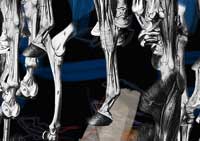 |
26.2.
-2.4.2017 Nonhuman Subjectivities Under-Mine Alinta Krauth Artist talk: 26 February, 2017 at 3PM The exhibition project investigates the problematics and possibilities of communicating nonhuman perception through the interface of artistic practice and new technologies. By means of interactive and non-interactive video that use generative and time-based techniques the Australian artist Alinta Krauth considers potential narratives of animals under threat from climate change. Australian artist Alinta Krauth 's new project Under-Mine (2017) was specially developed for Art Laboratory Berlin. She has used video, generative art, data visualisation and an intensive study into the science of animal perception and cognition to propose narrative paths towards a meeting point of the human and nonhuman. Taking into account that each species' way of sensing the world is unique, and often beyond the ken of human experience, Krauth makes use of a diverse technological toolbox to navigate and translate nonhuman perceptions. (More information) |
||||
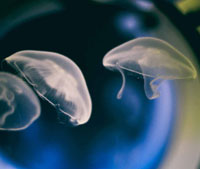 |
3.9.
- 9.10.2016 Nonhuman Subjectivities Aural Aquatic Presence Robertina Šebjanič Seminar: Living Systems | Aquatic Systems with Robertina Šebjanič, Kat Austen, Regine Rapp and Christian de Lutz: 18.9.2016 The exhibition investigates agency and sentience in one of the 'simplest' of multicellular creatures: the jellyfish, placing it into relation with a human made machine. Also noteworthy here is the importance of sound in marine systems, as well as the effects of human intervention on aural aquatic systems. In
her series of works Aurelia 1+Hz the Ljubljana based artist
Robertina Šebjanič
is interested in both biopolitical and technological attempts at
the prolongation of life as well as a new critical reflexion of
interspecies cohabitation. Šebjanič,
whose work involves intensive cooperation with marine biologists
from around the globe, has chosen to work with jellyfish, which
have existed on earth for over 500 million years. |
||||
|
|
2.7.-
4.9.2016 |
||||
 |
28.5.
- 17.7.2016 Nonhuman Subjectivities On Animals. Cognition, Senses, Play Rachel Mayeri Maja Smrekar The exhibition On Animals. Cognition, Senses, Play investigates two groups of animals that are closest to us. Primates, our nearest 'relatives', have a complex cognitive proximity to humans, but also differ radically in certain areas. While dogs, with whom we have made a symbiotic contract., have evolved alongside us over the last 30,000 years. The works in this exhibition share Donna Haraway's concept of "cooperative actions": overcoming conventional dichotomies of nature/culture, human/animal or subject/object is all about joint action. The artists, Maja Smrekar and Rachel Mayeri, make use of certain narrative strategies and the phenomenon of immersion, to approach the perspective of a nonhuman counterpart. The works of both artists place the instinct and the senses of the nonhuman at the centre of artistic research, while aiming to translate the nonhuman cognitive ability by means of the performance, film and art/science collaboration. (More information) |
||||
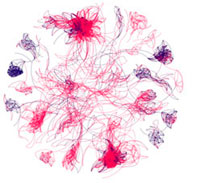 |
27.2.
– 30.4.2016
|
||||
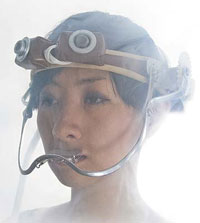 |
|
||||
 |
29.8.
- 20.9.2015
|
||||
 |
25.04.
- 21.06.2015 bOdy pandemOnium Immersion into Noise works by Joseph Nechvatal Artist Talk & Noise Music Concert: 25. April, 14 Uhr Joseph Nechvatal (born in 1951 in Chicago) is a post-conceptual artist working in digital art. He is one of the most important pioneers of 'new media art,' but at the same time makes use of 'old media' (such as painting and drawing). What is phenomenal, and in our opinion relevant to the 21st century, is that his paintings are created through a use of custom artificial life software and computer robotics.. (More information) |
||||
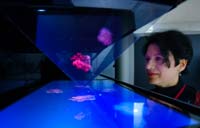 |
24.1.2015
- 29.03.2015 [micro]biologies II: πρωτεο / proteo - Joanna Hoffmann Joanna Hoffmann Opening: 23 January, 2015, 7PM Opening of the [macro]biologies & [micro]biologies Library: 30. January, 2015, 7PM Curators Talk: 1 March, 2015, 3PM [micro]biologies
II: πρωτεο
/ proteo featuring artworks by Joanna
Hoffmann is the fourth and final exhibition of the [macro]biologies
& [micro]biologies series at Art Laboratory Berlin.
The exhibition explores the minute biomolecules that form a basis
for the phenomena of life. |
||||
 |
27.9.2014
- 30.11-2014 [micro]biologies I: the bacterial sublime Anna Dumitriu Artist talk: 28 September 2014, 3PM Workshop with Anna Dumitriu: 30 November, 2014 The third exhibition will be a solo retrospective of British artist Anna Dumitriu, whose work in the field of art and science brings together historical narratives, cutting edge biomedical research and an interest in ethical concerns. Dumitriu is well known for creating "The VRSA Dress" & and "The MRSA Quilt" which were made from so-called 'superbugs'. To create those works she grew bacteria onto textiles and used natural and clinical antibiotics to create patterns (sterilised prior to exhibition). The
exhibition will also include works from her "Romantic Disease"
series which explores the history of tuberculosis (TB) from artistic,
social and scientific perspectives and covers subjects such as superstitions
about the disease, TB's literary and romantic associations, the
development of antibiotics and the latest research into whole-genome
sequencing of mycobacteria.
|
||||
 |
31.5.2014
- 20.7.2014
|
||||
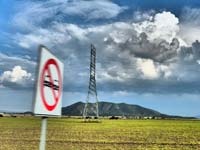 |
8.3.2014
- 4.5.2014 [macro]biologies I: the biosphere Katya Gardea Browne The Center for PostNatural History Mathias Kessler Alexandra Regan Toland Artist Talk with Katya Gardea Browne: 30 March, 2014 at 3PM Instead of a unified conception of existence, such as "world" or "nature", today, in the post-anthropocentric era, we find ourselves confronted rather with a multiplicity of structures and a blurring of boundaries. This show is part of a series of exhibitions - [macro]biologies and [micro]biologies - dedicated to artistic reflection on current drastic changes to how we connect, relate and interrelate to the worlds around us. For
[macro]biologies I: the biosphere we have chosen four important
international artists dealing with the structures and systems of
our world. The exhibition focuses on the ecosystem and the biosphere
with billions of life forms that interrelate with other systems
(i.a. geologie and climate). |
||||
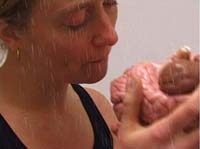 |
1.6.2013
-21.7.2013 Synaesthesia. Discussing a Phenomenon in the Arts, Humanities and (Neuro-) science" 5 & 6 July, 2013, Glaskasten Theatre, Prinzenallee 33, More information Synaesthesia / 4: Translating, Correcting, Archiving presents works by Ditte Lyngkær Pedersen (DK), Eva-Maria Bolz (D) and Andy Holtin (USA). The exhibition devotes itself to selected artistic strategies for decoding the phenomenon of synaesthesia. It is significant that all three artists experience different forms of synaesthetic perception. Ditte Lyngkær Pedersen's project Why Is Green a Red Word? is comprised of interviews with synaesthetes and scientists, but also includes conceptual video works such as What the Hell does Purgatory Look Like? and drawings depicting the spatial imagination of number forms by different synaesthetes. Contemporaneous with the exhibition opening will be the publication of Ditte Lyngkær Pedersen’s artist book Why is Green a Red Word?
Andy
Holtin has grapheme synaesthesia, connected with a particular
colour-number association. In his video Corrections (2009)
you can see how a hand colours in the numbers of different signs
and nameplates in photographs. Corrections demonstrates the
gap between the object and subjective sense perception as well as
the personal impressions of the artist himself. In his video Connections
(2013) the artist examines the complications he experiences when
objects share a colour with a particular number due to Holtin’s
individual synaesthetic experience, creating an extended perceptual
relationship.
|
||||
|
|
23.3.2013
- 12.5.2013 History of the Senses deals with the phenomenon of synaesthesia from the point of view of art and media history. The two artistic positions refer back to different movements from the 20th Century giving Art Laboratory Berlin's four-part exhibition series on synaesthesia a historical component, whilst nevertheless dealing with contemporary issues. A Banquet for Ultra Bankruptcy, developed for Art Laboratory Berlin by Carl Rowe & Simon Davenport, forms the starting point for a series of performances followed by an exhibition. The overarching theme of synaesthesia provides a basis for the study of aesthetics, politics and participation, as well as for the reactions of the participants. A Banquet for Ultra Bankruptcy is made up of five performances for six guests. During a six-course menu selected foods are combined with images, sounds and scents. Each course is designed as an aesthetic experience, allowing the audience to participate in simultaneous sensations. The
work Circus 8 (1986/2008) by Sergio Maltagliati &
Pietro Gross consists of eight pieces and is based on Grossi's
HomeArt programs from the 1960s and 1970s, which automatically generated
sound. Maltagliati has expanded Grossi's principle with software
programs and added visual graphic variations. The visual data generated
by the computer approximates the graphic score for a sound composition.Whilst
the work Circus 8 adds a media historical dimension to Art
Laboratory Berlin's Synaesthesia series, it also brings an
important new component into the discussion: the computer as artificial
brain with its own form of digital synaesthesia.
|
||||
|
26.1.2013-10.3.2013 Inquiries into the nature of Space and Perception are the basis of Art Laboratory Berlin's second exhibition in the Synaesthesia series. Synaesthesia, the experience of two or more sensory impressionsat the same time, is both an artistic paradigm and neurological phenomenon. Two installations by Madi Boyd and Carrie C Firman explore the connection between perception and experience of mind and body from a synaesthetic point of view. Madi Boyd is a synaesthete from Great Britain, whose artistic work focuses on perception and the brain. In collaboration with neuro-scientists, Dr. Mark Lythgoe and Dr. Beau Lotto, from University College London her work incorporates and combines installation, film and sculpture. Her recent project The Point of Perception explores how much information the human brain needs in order to know what it is looking at. Carrie
C Firman is an emerging electronic artist from the US. Her work
is inspired by studying and experiencing the crossing of senses.
She sees synaesthesia not only as a sensory phenomenon, but also
a fantastic world interface, responsible for completely unique perceptual
experiences. |
|||||
 |
|||||
 |
27.10.2012
- 16.12.2012 28
October, 2012, 4PM - Artist talk and workshop with Barbara Ryan
The
work of the Berlin typographer and artist Annette Stahmer
revolves around language, the relationship between voice and writing,
the act of writing, palimpsests and synaesthesia. The two videos
in the exhibition - A ist blau and Synästhetische
Bilder I - IV - show the artist's mother, a synaesthete who
connects vowels with certain colours.
|
||||
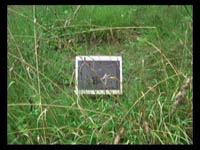 |
1.9.2012
- 14.10.2012 The
video installation Monitor by the American artist Dave
Hebb is a video and photographic documentation of an environmental
intervention extending over a one-year period. Hebb placed a computer
monitor outdoors and over the entire year documented changes to
the environment several times a week. His piece is played on old
computers and monitors and is inherently unstable, a common problem
of technology as it becomes obsolete. This self-reference is also
shown through the display of the video on the same type of monitor
that is the subject of the piece itself, which is presented more
as an object of media archaeology than merely a means of presentation |
||||
 |
24.03.2012
- 29.04.2012 Opening:
23 March, 2012, 8PM The
British artists Sam Belinfante and Simon Lewandowski produced The
Reversing Machine (A Theatre of Kairos and Chronos) especially
for this exhibition. The installation alludes to the notion of Kairos
as opportune time, as opposed to Chronos, the course of time.
The work Time Sifter is by the Israeli born and New York
based artist Shlomit Lehavi who works primarily with new media and
multi-channel video. Her video installation Time Sifter explores
collective memory, collective forgetting and time based media as
a contemporary time machine.
|
||||
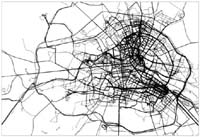 |
27.01.2012
- 11.03.2012 Opening:
27 January 2012, 8PM Navigating the Everyday presents works by plan b, the British artist duo Daniel Belasco Rogers and Sophia New, and is their first solo exhibition in Germany. Since 2003 and 2007 respectively, Daniel and Sophia have been recording every journey they make every day using GPS devices. Additionally all areas of their digital communication (e.g. mobile phone text messages) are evaluated and processed artistically. Their work represents an artistic research by means of a digital archiving of their movements. Over
the years this practice has become part of everyday life, a form
of private and personal 'sousveillance', in which the artists generate
their own data, thereby reflecting the approach of those private
and public agencies who collect all available data.
|
||||
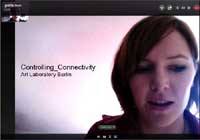 |
25.11.2011
- 15.01.2012 Controlling_Connectivity 14
January, 2012 3.30PM: Tour of the exhibition and Artists' talk
with Gretta Louw The
exhibition project Controlling_Connectivity by the Australian
artist Gretta Louw is a reflection of the latest forms of digital
communication. Her online performance (2- 12 November 2011) has
laid the basis for an exhibition which will include screen capture
footage, photographs and an installation. For 10 days the artist
was available 24 hr/day for discussions, emails, comments, or interviews
- of both private and professional nature - for any internet user
wishing to take part in the project. |
||||
 |
10.09.2011
- 16.10.2011 In VISIONS NYC - afterthoughts the Berlin-based artist and photographer Bärbel Möllmann has gathered a series of amazing portraits and interviews with New Yorkers from Summer 2001, recording their individual plans, goals and dreams, and from Summer 2002 recording their reactions to the events of the previous year. When
she began her unique artistic project in July 2001, Möllmann
could not have imagined the attacks on the Twin Towers that would
occur only two months later. The actual events of 9/11 are not directly
seen in the images, but rather felt as a historic turning point
in the interviews and photos taken both before and after September
11. The project is rather about individual New Yorkers and their
respective fates, which are brought convincingly near in these artistic
photographs and authentic interviews, which shows just how strongly
the city of New York and its residents changed in the aftermath
of September 11.
|
||||
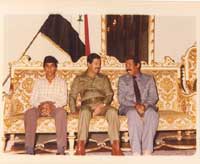 |
29.04.2011
- 26.06.2011 Round table discussion Al Tahrir: The Day After, 1 May, 2011, 3PM My
Dreams Have Destroyed My Life. Some Thoughts on Pain was first
conceived by the artists during a common artist residency in Taiwan.
Both artists had lost brothers in respective conflicts in their
countries of origin. Al Fadhil has lost two brothers to the wars
in Iraq. One brother died in the Iran-Iraq war. Fadhil's father,
as the parent of a 'martyr,' were granted an audience with the dictator
Saddam Hussein, which was documented with a photograph.
|
||||
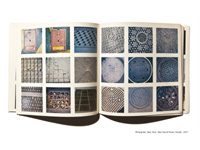 |
22.
01.2011 - 13.3.2011 Opening:
21 January 2011, 8PM The American artist Sol LeWitt (1928 - 2007) was an influential figure in minimalism and is considered one of the most important representatives as well as co-founder of American conceptual art. The term "conceptual art" goes directly back to LeWitt: "If the artist carries through his idea and makes it into visible form, then all the steps in the process are of importance. The idea itself, even if not made visual, is as much a work of art as any finished product. All intervening steps - scribbles, sketches, drawings, failed works, models, studies, thoughts, conversations - are of interest. Those that show the thought process of the artist are sometimes more interesting than the final product." (Paragraphs, Artforum, June 1967) LeWitt's
intensive artist books production was extremely versatile: he used
different designs and formats as well as varied techniques from
color lithography to offset printing. Finally the phenomena of reproducibility
was part of the concept: "Also, since art is a vehicle for
the transmission of ideas through form, the reproduction of the
form only reinforces the concept. It is the idea that is being reproduced."
(ibid.)
|
||||
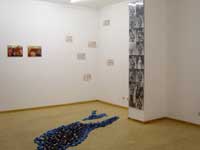 |
30.10.2010
- 28.11.2010 Stardust Boogie Woogie Tania Antoshina, Mo Foster, Marcela Iriarte, Christian de Lutz, Jane Mulfinger, Bob & Roberta Smith, Jessica Voorsanger. curated by Francesca Piovano Opening 29 October 2009 8PM Finnisage:
26 November 2010 8PM Stardust Boogie Woogie When Andy Warhol declared that everyone would be famous for 15 minutes, he probably didn't realized how true that was going to be. It is no longer necessary to have a particular talent, nowadays absolutely any one who is prepared by whatever means to be entertaining, can become a 'celebrity'. Then mass media, along with popular culture, will see that celebrities are consumed as spectacle giving them a package of meanings that has nothing to do with their intrinsic value. To
explore the issues of celebrity cult and modern heroes and to put
them in a multifaceted international context, the exhibition Stardust
Boogie Woogie has brought together 7 artists from different
countries and backgrounds. Their work is around the notion of stardom
and its related lifestyle (Jessica Voorsanger, Jane Mulfinger, Marcela
Iriarte), of socialist personality cults (Christian de Lutz, Tania
Antoshina) and of popular culture (Bob & Roberta Smith, Mo Foster).
|
||||
|
|
28.8.2010
- 26.09.2010 Alex Toland and Myriel Milicevic - Wunschgarten: Wild Urban Offshoots Opening:
27 August 2010, 8PM The
exhibition Wunschgarten: Wild Urban Offshoots is a collaboration
by the artists Alex Toland and Myriel Milicevic and part of the
series Artists in Dialog. Both work on the border between
art and life and environmental sciences. Together they have chosen
the immediate area around Art Laboratory Berlin (the Soldiner Kiez)
as a place to investigate interactions between the local human population
and urban flora and fauna. The exhibition functions as a laboratory
for the production of maps, drawings, models and prototypes. Wunschgarten
is a series of dialogues: between the artists and the local community,
between city dwellers and nature, between urban planning and urban
wilderness. Toland considers the project 'habitat hacking' and Milicevic
describes the project as 'reconstructing cross-species life worlds'.
|
||||
 |
29.05.2010
- 27.06.2010 Artists in Dialog 2-1/4-n/2 x 21/4-n/2 Heidi Hove & Jens Axel Beck Opening:
Friday, 28 May, 2010, 8 PM The
exhibition 2-1/4-n/2 x 21/4-n/2
by the Danish conceptual artists Heidi Hove and Jens Axel Beck is
the first exhibition in our new series Artists in Dialog.
Both are interdisciplinary artists, whose practice includes sculptural
objects and installations as well as architectural, spatial and
social interventions. A point of convergence in their work is a
focus on daily life and the public and private spaces that we daily
travel through. Their work examines how we navigate and organise
ourselves in the world. Through simple and diverse manipulations,
the daily and the recognisable are brought out of their regular
condition.
|
||||
|
|
24.04.2010
- 22.05.2010 Opening:
Friday, 23. April 2010, 20 Uhr The
exhibition project OFF FENCE. Art on the Californian-Mexican
Border is an artistic platform with five positions, exploring
the cultural overflow, overlap and tensions in the border region
of Southern California and Northwest Mexico. The artists come from
Los Angeles and Mexico City.
|
||||
|
Azin Feizabadi, from Repititions-Revolutions -Rituals |
28.11.2009
- 07.02.2010 Azin
Feizabadi, Gilbert & George, Christian de Lutz, Triple Candie Opening
27 November 2009, 8PM Creative Rights. On Appropriation, Copyright and Copyleft investigates questions concerning the use, re-use and misuse of images and information in the contemporary art world from artistic, legal, political and philosophical viewpoints. Since the late 1970s appropriation of images and information by such artists as Sherrie Levine and Richard Prince has become a common and accepted technique, part and parcel of postmodernism's critical approach. Indeed it follows a tradition that goes back through pop art and nouveau realisme to Dada and cubist collage. Not without ethical, aesthetic and legal controversy, a number of law cases involving appropriation seems to have increased in recent years involving artists such as Jeff Koons, Richard Prince and Shepard Fairey. The exhibition Creative Rights consists of three parts: The exhibition with four artistic positions, the Creative Rights Library with extensive material on the presented artists and other recent law cases as well as a workshop on the theme of copyright.
|
||||
|
|
02.10.2009
- 15.11.2009 Opening:
2. October 2009, 8PM The exhibition Seized by Critical Art Ensemble (CAE) and the Institute for Applied Autonomy (IAA) is the third part of our series Art and Law. The exhibition documents the FBI raid on the house of CAE member Prof. Steve Kurtz in May 2004, following the death of his wife Hope. In the weeks prior to the raid Steve and Hope Kurtz had been preparing for an exhibition examining GM agriculture at Mass. MOCA. An
emergency worker of the fire department responding to Steve Kurtz's
911 call found materials in their houserelated to the upcoming exhibition
suspicious and informed the FBI. The raid, conducted by FBI-officers
wearing hazmat suits, and blocking off a half block radius of the
home, caused much media attention. (more
Information) |
||||
| Photo copyright 2009 by Michael J. Mulley | |||||
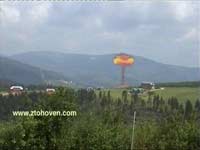 |
30.05.2009
- 28.06.2009 Filmscreening:
On Media Reality The Prague based artist collective Ztohoven use their work, often interventions in public space, to scrutinise the creditability of mass media and advertising. In their action Media Reality, which took place on 7 June, 2007, they ‘hacked’ into the Czech weather channel ČT 2 and added the image of an atomic explosion to the live image of a mountain valley. The channel pressed charges under laws against “indecent behavior” and the “diffusion of false information”. In two separate legal actions members of the group were acquitted. At the same time, Ztohoven were awarded the first NG 333 prize for contemporary art from the Prague National Gallery, in connection with Media Reality Besides
showing the work Media Reality and related court documents,
Art Laboratory Berlin will present the German premiere of
the film On Media Reality, which documents the legal and
artistic aftermath of the action. The film’s director Vladimir
Turner will be present at the opening on 29 May.(more
information)
|
 |
21.02.2009
- 29.03.2009 Lecture by Maksim Neroda (CAT): 22 March 2009, 5PM The
CAT (Contemporary Art Terrorism) collective from Novosibirsk
creates situations in public space, which lay bare the absurdity
of the way in which political power functions. Unprepared passers-by
were drawn into the process of creating critical artistic statements.
For organizing a May Day monstration - a counterpart to a classical
May Day demonstration - in which marchers carried individual banners
with apolitical, often poetic or non-rational slogans, the artists
were sentenced to pay a fine. The exhibition Monstration
shows video works and documents of the public reaction by means
of legal documents and mass media reviews.
|
|
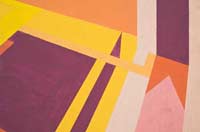 |
29.18.2008
- 04.01.2009 The
exhibition revolves around issues of design, of the construction
of surfaces we are surrounded by in everyday life: from textiles
to texts, to street and city. One of the underlying intentions of
the exhibition is to reflect on how these formal constructions organize
our behaviour, give our lives a scheme, a program, and on the sedimentation
of ideology in forms.
|
 |
24.10.2008
- 16.11.2008 Tour
of the exhibition: 02 November 2008, 3PM
|
 |
30.08.2008
- 28.09.2008 Artist's
talk: 31 August 2008, 5PM
|
 |
30.05.2008
- 29.06.2008 Artist's
talk: 14 June 2008, 5PM
|
|
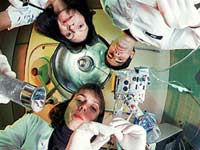 |
29.03.2008
- 04.05.2008 Artist's
talk and workshop:
29 March 2008, 5PM Contemporary Art already long ago turned away from a solely anthropocentric point of view. Currently in Science Art, it is concerned, among other things, with ecological phenomena and is investigating the existence of newly emerging life forms; Art and Science have been combined. The Kaliningrad based artist Dmitry Bulatov views the contemporary art scene as a kind of petri dish of living material for his investigations. Coming from his own artistic experience he has investigated this sphere and explored its dynamics and spatial vectors. In connection with his scientific research and artistic practice, Bulatov has staged an active evolutionary dramatisation of ‘post-biological’ forms whose paradoxical development may completely change our idea of the surrounding world. (more)
|
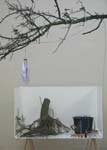 |
26.01.2008
- 2.03.2008 Workshop
with Denisa Kera (curator): Curating New Media: 27.01.2008 5 PM The Czech new media art scene could be characterized by a latecomer strategy which in recent years is turning its disadvantages into a source of advantage. As video art and other trends from the 1980s and 1990s were never strong in the Czech art academies, young artists feel free to experiment and often develop very promiscuous relations to different traditions, trends and technologies. (more)
|
|
 |
23.11.2007
- 6.01.2008 Artist's
talk: Sunday, 06 January 2008, 5pm
|
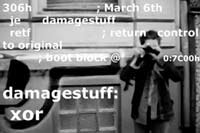 |
28.9.2007
- 28.10.2007 Art
and Text II Christian
de Lutz has worked as a photographer and visual artist since moving
to Europe in 1994, after having worked in painting and video in
New York during the late 1980s and early 1990s. During these years
de Lutz has built up a considerable photo archive, which he has
used as the basis to create his current images. The original analogue
photographs have been processed through digital imaging software;
some information has been taken away, while new information has
been added. In the last seven years the artist has increasingly
worked at the periphery of image and text. By means of a digital
montage of photography and source code or algorithmic texts his
pictures have generated a palimpsest-like layering of pictorial
and literary signs.
|
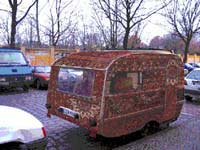 |
31.8.2007
- 23.09.2007 Art
Laboratory Berlin is pleased to present a solo exhibition of book
art, drawings and a digital work by Farkhondeh Shahroudi as part
of the series Art and Text.
|
 |
30
June- 22 July 07 Viktor Alimpiev, whose work Summer Lightings was shown at the 4th Berlin Biennale in the Former Jewish Girls' School, combines different artistic fields in his cinematic work: visual arts, music, theater and dance. In his films he has worked with the human body and more recently with song and speech. During the 2005 Venice Theatre Biennale he directed the play We're Talking about Music in Italian language together with Marian Zhunin. In Linz in 2006 he created the video Wie heisst dieser Platz? in German. (more information)
|
 |
25
May - 17 June 07 The 3-Room-Conference is a performance project, which was organized by the Berlin Tiefenrauschorchester especially for the rooms of the artspace Art Laboratory Berlin. In connection with his painting Inbetween (2001) and his film projection Cloud Pieces (2005) Leo Königsberg will realize a sound collage on his space cello. This audiovisual production will be taken further by the live act by Christian Glass' electronic acoustics. The dance performance by janusz de woyciechowski, in relation to his film Titania (1970), which will be projected in the art space, will develop this interdisciplinary experiment through the human body in movement. (more information)
|
 |
30
March 07 - 20 May 07 The Group PG was founded in 1998. It now consists of Ilya Falkovsky, Alexey Katalkin and Boris Spiridonov. PG is a play on words that can be interpreted differently, for example as “Criminal Group”, “Hydrant” or “Hand Grenade”. The group activity is multifunctional. It publishes its own magazines and postcards, releases musical albums, makes comics and performances. (more information)
|
|
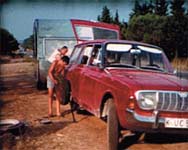 |
'pre-opening'
23 February 2007 A documentary
film by Nicola Hochkeppel A 1960's and 70's West German vacation idyll. The Hubert J. Wagner family of Cologne – all nine of then – trapped between the „simple life“ romanticism of camping and the educated middle-class ideal of classics-based scholarship. Tax consultant Wagner, the arch-catholic clan patriarch, suffers no amendments to his meticulous plans for the rigorous summer pilgrimages. Using the family's home-movie footage (1965 – 1975), the documentary film LEARNING BY CAMPING also chronicles a chapter of German social history during the heyday of the flourishing welfare state.(more information) |
| Sponsored by: | ||||||
| Other sponsors and partners | ||||||









